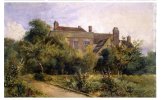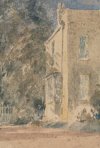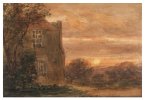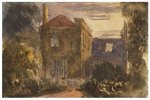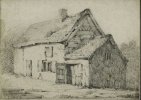This is from a local guide to blue plaques around Harborne (Egbastonvillage.co.uk)
David Cox, considered one of the greatest English landscape painters, was born in Deritend Birmingham, the son of a blacksmith and a farmer’s daughter. At 15, he was apprenticed to a miniaturist painter, moving to theatre scene-painting two years later. Although resolved to becoming a professional artist, his living came mainly as a drawing teacher and author of a number of books on landscape painting. In 1805 he first visited Wales, the landscape inspiring many of his future works.
In 1813 Cox was appointed to teach drawing at the Royal Military College, but resigned upon finding the environment too constraining. Married and with a young son, he moved to Hereford where he taught for 5 years at a girls’ school. In 1827, he returned to live in London, exhibiting at the Society of Painters in Water Colour, but also at the first exhibition of the Birmingham Society of Artists.
He continued with his iconic watercolours for the rest of his life, then in his fifties he also began to paint and exhibit in oils. In 1841 the family returned to Birmingham to live in Greenfield House, which remained his home until his death. He is buried beside his wife in the churchyard of St. Peter’s Church, Harborne.
His son captured the Harborne family home in the paintings below. Samuel Lines drew the birthplace (Deritend) of David Cox snr in a sketch, also attached below.
David Cox, considered one of the greatest English landscape painters, was born in Deritend Birmingham, the son of a blacksmith and a farmer’s daughter. At 15, he was apprenticed to a miniaturist painter, moving to theatre scene-painting two years later. Although resolved to becoming a professional artist, his living came mainly as a drawing teacher and author of a number of books on landscape painting. In 1805 he first visited Wales, the landscape inspiring many of his future works.
In 1813 Cox was appointed to teach drawing at the Royal Military College, but resigned upon finding the environment too constraining. Married and with a young son, he moved to Hereford where he taught for 5 years at a girls’ school. In 1827, he returned to live in London, exhibiting at the Society of Painters in Water Colour, but also at the first exhibition of the Birmingham Society of Artists.
He continued with his iconic watercolours for the rest of his life, then in his fifties he also began to paint and exhibit in oils. In 1841 the family returned to Birmingham to live in Greenfield House, which remained his home until his death. He is buried beside his wife in the churchyard of St. Peter’s Church, Harborne.
His son captured the Harborne family home in the paintings below. Samuel Lines drew the birthplace (Deritend) of David Cox snr in a sketch, also attached below.
Attachments
Last edited:

